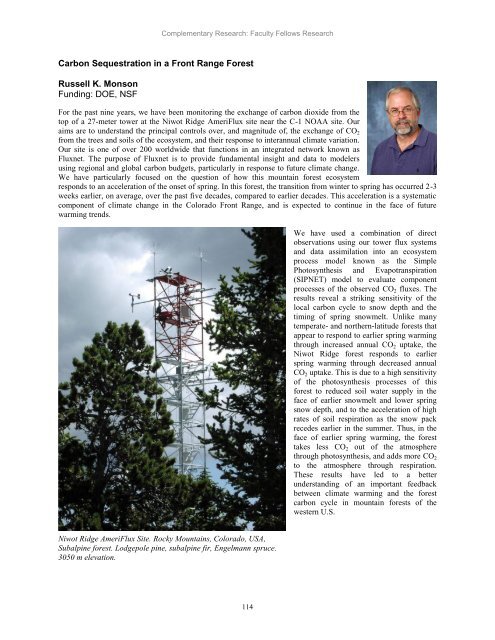Scientific Theme: Advanced Modeling and Observing Systems
Scientific Theme: Advanced Modeling and Observing Systems
Scientific Theme: Advanced Modeling and Observing Systems
Create successful ePaper yourself
Turn your PDF publications into a flip-book with our unique Google optimized e-Paper software.
Complementary Research: Faculty Fellows Research<br />
Carbon Sequestration in a Front Range Forest<br />
Russell K. Monson<br />
Funding: DOE, NSF<br />
For the past nine years, we have been monitoring the exchange of carbon dioxide from the<br />
top of a 27-meter tower at the Niwot Ridge AmeriFlux site near the C-1 NOAA site. Our<br />
aims are to underst<strong>and</strong> the principal controls over, <strong>and</strong> magnitude of, the exchange of CO2<br />
from the trees <strong>and</strong> soils of the ecosystem, <strong>and</strong> their response to interannual climate variation.<br />
Our site is one of over 200 worldwide that functions in an integrated network known as<br />
Fluxnet. The purpose of Fluxnet is to provide fundamental insight <strong>and</strong> data to modelers<br />
using regional <strong>and</strong> global carbon budgets, particularly in response to future climate change.<br />
We have particularly focused on the question of how this mountain forest ecosystem<br />
responds to an acceleration of the onset of spring. In this forest, the transition from winter to spring has occurred 2-3<br />
weeks earlier, on average, over the past five decades, compared to earlier decades. This acceleration is a systematic<br />
component of climate change in the Colorado Front Range, <strong>and</strong> is expected to continue in the face of future<br />
warming trends.<br />
Niwot Ridge AmeriFlux Site. Rocky Mountains, Colorado, USA,<br />
Subalpine forest. Lodgepole pine, subalpine fir, Engelmann spruce.<br />
3050 m elevation.<br />
114<br />
We have used a combination of direct<br />
observations using our tower flux systems<br />
<strong>and</strong> data assimilation into an ecosystem<br />
process model known as the Simple<br />
Photosynthesis <strong>and</strong> Evapotranspiration<br />
(SIPNET) model to evaluate component<br />
processes of the observed CO2 fluxes. The<br />
results reveal a striking sensitivity of the<br />
local carbon cycle to snow depth <strong>and</strong> the<br />
timing of spring snowmelt. Unlike many<br />
temperate- <strong>and</strong> northern-latitude forests that<br />
appear to respond to earlier spring warming<br />
through increased annual CO2 uptake, the<br />
Niwot Ridge forest responds to earlier<br />
spring warming through decreased annual<br />
CO2 uptake. This is due to a high sensitivity<br />
of the photosynthesis processes of this<br />
forest to reduced soil water supply in the<br />
face of earlier snowmelt <strong>and</strong> lower spring<br />
snow depth, <strong>and</strong> to the acceleration of high<br />
rates of soil respiration as the snow pack<br />
recedes earlier in the summer. Thus, in the<br />
face of earlier spring warming, the forest<br />
takes less CO2 out of the atmosphere<br />
through photosynthesis, <strong>and</strong> adds more CO2<br />
to the atmosphere through respiration.<br />
These results have led to a better<br />
underst<strong>and</strong>ing of an important feedback<br />
between climate warming <strong>and</strong> the forest<br />
carbon cycle in mountain forests of the<br />
western U.S.
















